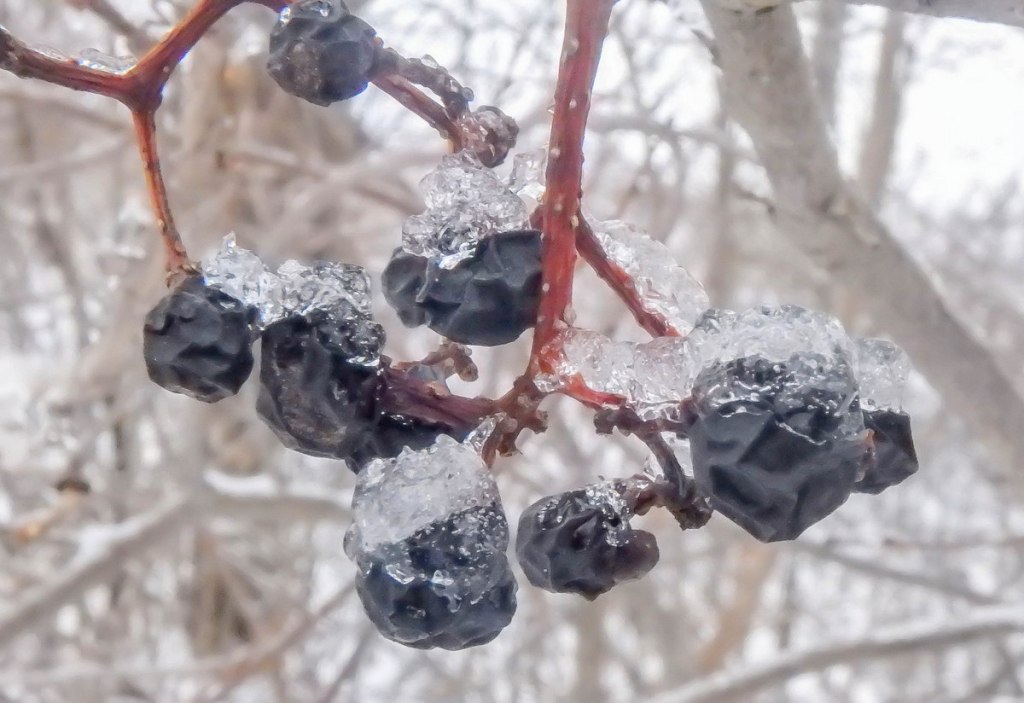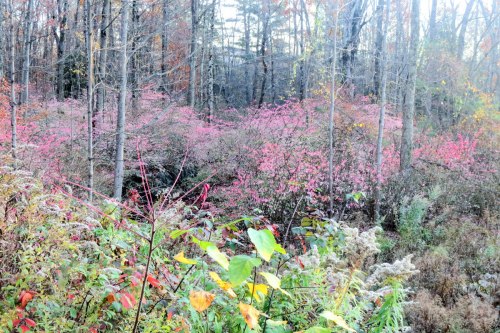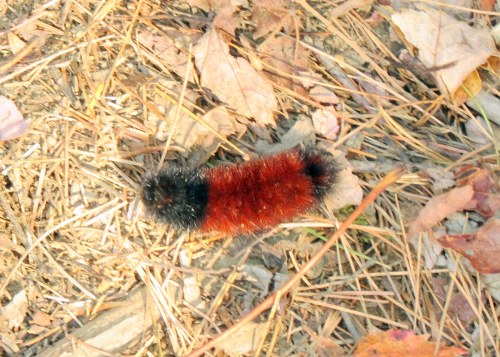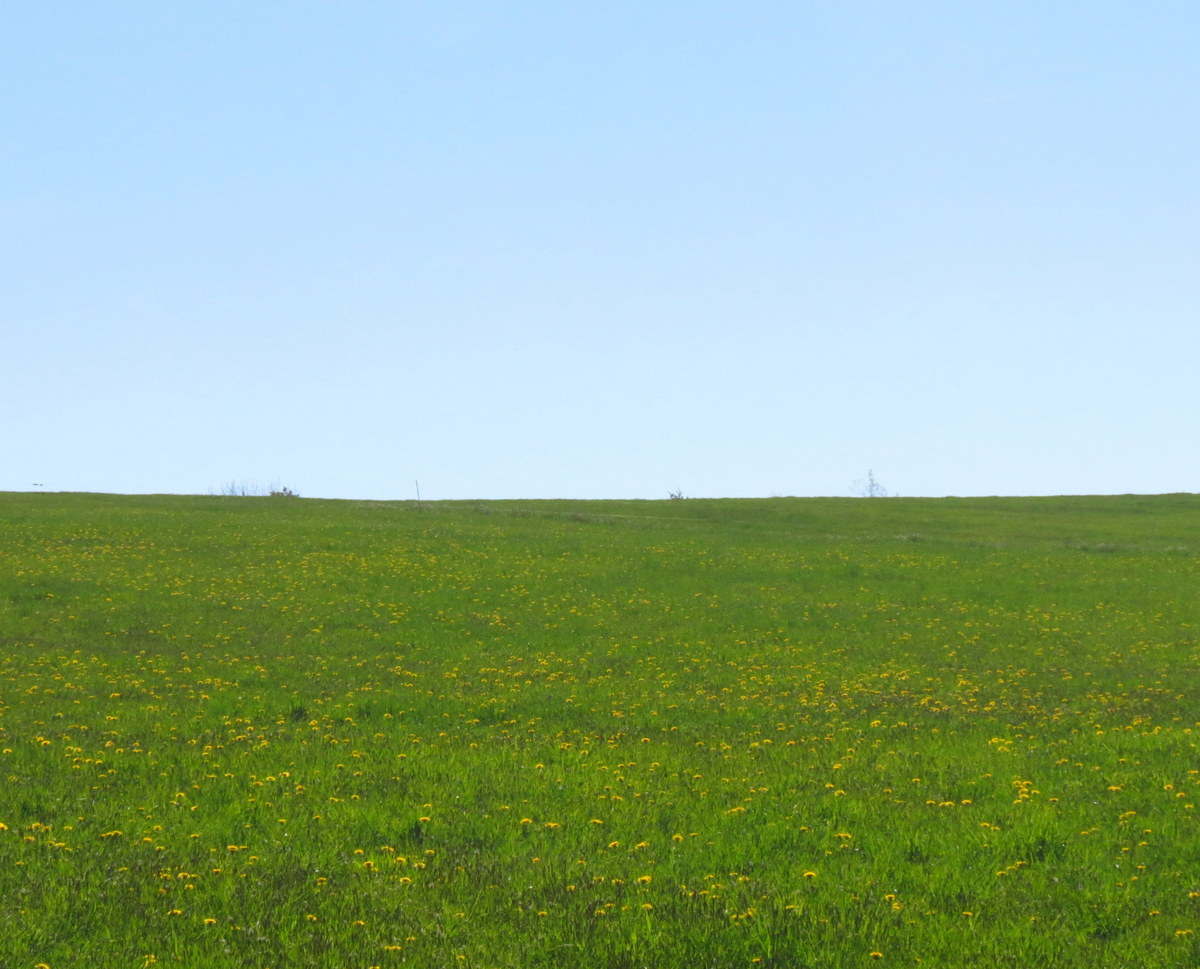
Two days before I went on a walk down a rail trail in Keene temps were in the 50s F and the sun was shining. Then we had a storm and though some parts of the state saw eight inches of snow we saw about an inch and a half of glop. Glop, for those who don’t have to deal with it, is snow, rain and sleet all falling in the same storm. It freezes into white concrete and about all you can do with it is wait for some sunshine to come and melt it away.

As soon as I stepped onto the trail I was getting mixed messages. While someone wore Yak Tracks….

…. someone else rode a bike. I supposed I’d have to find out for myself if it was icy or not. It was certainly cold enough for ice at 30 degrees, and with the strong breeze coming over the hills to the west, it felt more like 20. You have to give weather like this a chance if you are going to be a nature nut, and you give it a chance by being smart about it and dressing for it. I was dressed for it and I knew that, once I started seeing things that grabbed my interest, I wouldn’t feel cold at all.

Sure enough though it was a gray, bleak looking day there were plenty of warm colors to be seen and all thoughts of cold left me when I saw a tree full of bright orange-red crap apples. Not a single one had been touched by birds and that may have been because they were quite large for a crabapple. I doubted any bird I know could swallow one. Also, though it grew here “wild” it might not have been a native crabapple. Many crab apples are ornamental cultivars that birds just don’t like. Some other cultivars have fruit that birds will eat only after it has frozen and thawed several times. For whatever reason they didn’t like these, even though there are usually birds everywhere out here.

These hazelnut catkins were encased in ice and that told me that it must have rained and then gotten cold fast. I can’t explain the hair. Maybe it’s not a hair at all. It could be a bit of silk left by a spider. Whatever it is I see things just like it everywhere I go, on all types of plants.

Virgin’s bower (Clematis virginiana) grows long feathery filaments called styles on its seeds (fruits) so the wind can carry them long distances. Botanically speaking these “seeds” are achenes, which are fruits with one seed. But how can the wind carry them away when they’re always wet, as they have been this year? Now they aren’t just wet, they’re frozen together. Maybe they’ll just wait for spring. Meteorological spring, which starts on March first, is only 69 days away. Astronomical spring will take a bit longer and that’s why I prefer meteorological spring. Meteorological spring is based on temperature cycles for a three-month period when temperatures are similar, as in March, April and May. Summer is June, July and August and fall is September, October and November. Winter of course, is what is left.

Oriental bittersweet (Celastrus orbiculatus) grows all along this trail and though its berries add a bright spot of color in winter it is terribly invasive.

Almost all of this mass of vines seen here is Oriental bittersweet. They twine around trees with the strength of steel cables to get to the tree’s crown where there is more sunlight. Once there they compete with the tree for light while strangling it from below. Eventually the tree dies and falls over, and I’ll never understand how that benefits the bittersweet, which wants all the sunshine it can get.

This hole was probably six to eight inches across, and I thought it looked like a woodchuck’s hole. I didn’t see any tracks around it though so it might just be an escape tunnel, but someone falling into it could break an ankle.

A birch polypore lived up to the name of “shelf fungus.” There was a group of them at the base of this tree which had all had bites taken out of them. I’d guess by squirrels, but specific information about which animals eat this fungus is very hard to come by.

A tree had fallen and I was surprised to see that its upper branches had fomed a witch’s broom. The only other tree this big that I’ve seen with a witches’ broom was an old white pine that has since fallen. Witches’ broom is a deformity described as a “dense mass of shoots growing from a single point, with the resulting structure resembling a broom or a bird’s nest.” Witches’ broom can cause desirable dwarfism and increased branching in some plants. In fact, many well known dwarf evergreen shrubs are the result of witches’ broom. For example, Montgomery Dwarf Blue Spruce is one of the best dwarf blue spruces, and it is from a witches’ broom. Though this tree had lost almost all its bark I think it was a black birch (Betula lenta).

Mount Monadnock off to the east had its head in the clouds. I had my head in the clouds too whaen I was a teenager and one of my major dreams as was to pick up where Henry David Thoreau left off and finish cataloging the wildflowers that grew on the mountain. Then one day I helped the ladies of the Keene Garden Club plant wildflowers on the mountain’s flanks to reestablish some species which were thought to have once grown there and that’s when I saw that, even if you lived three lifetimes you wouldn’t have time to find and catalog every flower that grew there. That’s a big mountain.

The wide ditch that runs alongside the railbed has been full of water all year long. We’ve had more rain than I can ever remember.

Often in the fall deer tongue grass (Dichanthelium clandestinum) will turn many colors, with maroon, purple and orange or yellow sometimes on the same leaf. It’s quite pretty and I’ve searched high and low to find some so I could show it to you but every plant I’ve seen has been uniformly tan, just as these were. It seems kind of odd after seeing them so colorful all of my life.

There are lots of staghorn sumac berries (Rhus typhina) out here that the birds haven’t eaten but they’ll probably be gone by spring. I’ve read that they’re low in fat so they aren’t a bird’s first choice.

Sumac means red in many of the old languages and that makes perfect sense because everything about it is red. Even these long dead staghorn sumac leaves still held their red color. The plant is said to be rich in tannins and dyes in colors like salmon and plum can be made from it.

Sumacs fall over regularly and whenever I see one, I look at the inner bark to see the rich red color but the color only lasts for a short time and I found none of it on this tree. I did some reading about sumac wood when I got home and found that wooden flutes can be made of it.

I can’t remember ever seeing invasive burning bushes (Euonymus alatus) out here when I was younger but there are a few here now. Usually the bracts that cover the berries are black but on this plant they were bright red. I’ve never seen this on a wild (escaped) plant.

These Virginia creeper berries (Parthenocissus quinquefolia) made me shiver but I wondered why they hadn’t been eaten. They and the Oriental bittersweet and burning bush berries we’ve seen are usually among the first to go. I’ve seen hawks flying around in this area and I wonder if they’ve scared all the birds away.

Common greenshield lichen (Flavoparmelia caperata) is very common and can be found on many of the trees here. It’s a large lichen and colonies of them often grow big enough to cover entire trees. They often wrinkle like the example seen here. Like many lichens they change color, and go from grayish when dry to yellow green when wet. They often have patches of granular soredia on them as this one did. A soredium is a tiny granular ball of fungal hyphae and algal cells. They can grow on the body of the lichen or on its margins and might eventually fall off to make new lichens. No matter what living thing you find in nature it’s always about the continuation of the species, and the will to survive is strong in all of the things I see.

Leaves shivered and rattled in the strong breeze. Though they were maple they spoke beech. A man came walking down the trail as I was taking this photo and said good morning. I retuned his greeting and remarked on the cold. “Yes” he said, “it’s cold, but it’s white.” Must be a winter lover, I thought. I’m not a winter hater but at that point I’d had enough to last for a while, so I turned for home.
The splendor of Silence—of snow-jeweled hills and of ice. ~Ingram crockett
Thanks for coming by.

























































































































































































































